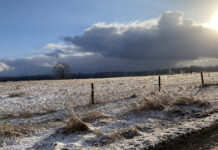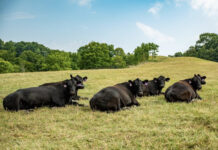One of the unexpected treats of collecting the first blackberries of the season is stumbling upon an active bird nest. Bramble thickets are prime nest sites for species such as cardinals, catbirds, song sparrows, yellow-breasted chats, and indigo buntings.
Males
Male indigos are easy to find and even easier to recognize. They sing a complicated song consisting of a series of double notes from high atop exposed perches. They want to be seen. And no other bird shares his deep metallic blue body.
Females
Female indigos, on the other hand, are drab, secretive little brown birds. They usually stay hidden in dense vegetation.
So imagine my surprise and delight a few days ago when I stepped into a blackberry thicket to grab one of the first berries of the year. I’d been watching these berries ripen for several days. As I reached for the plumpest fruit, a dark spot caught my attention just to the right of my hand. It was an eye of an incubating female indigo bunting.
She sat motionless after hunkering down in the nest. Because she sat so tightly, I concluded it was late in incubation. Incubating birds are reluctant to leave the nest as hatching approaches. I grabbed a single berry and retreated as quickly and quietly as possible. Fortunately, she remained on the nest.
Invisible nest
The nest was woven into the blackberry canes about 3 feet above the ground. From above, it was virtually invisible.
After stepping back, I examined the area around the nest more closely. It turned out my decision to wear long sleeves and long pants was a good one. Growing at the base of the thicket was a healthy stand of poison ivy — leaflets three, let it be. Though I seem to have outgrown the severe reaction I got from poison ivy when I was a boy, I never press my luck. When I see those shiny three leaflets, whether on a vine or a shrub, I avoid it.
Four hatchlings
I returned the next day and, using binoculars discovered the nest unattended. A quick peek revealed four tiny, naked hatchlings — a typical brood.
Almost on cue, the female returned and scolded me. Her alarm notes attracted her mate’s attention, and he joined the nest’s defense. Face to face with two angry indigo buntings, I took the hint and left immediately.
Judging from the uniform size of the four hatchlings, it was safe to assume this bunting nest had escaped one of the species’ greatest threats. Indigo buntings are a favorite host for brown-headed cowbirds.
Food supply
Cowbirds, brood parasites that lay their eggs in other birds’ nests, usually select host species that lay eggs that are smaller than theirs. That way when the eggs hatch, the larger cowbird chick has a competitive advantage. When parents bring food to the nest, cowbird chicks reach higher and open wider, and thus monopolize the food supply.
Often the result is that host chicks starve, and a single over-sized cowbird fledges from the nest. There are few stranger sights in nature than a parent bird feeding a begging cowbird chick that’s almost twice the size of the adult.
Since all the chicks I saw were the same size, none was a cowbird.
For the next week or so, however, the bunting chicks will be proverbial sitting ducks. Confined to a nest close to the ground, they are easy prey for snakes, cats, chipmunks, raccoons, opossums, skunks, foxes, crows, jays, and just about every other predator in the area.
Hidden nests
What the nest has going for it is its inconspicuousness. For predators to eat the chicks, they must first find them. Given how well hidden the nest is, that would probably be a random event. That indigo buntings are fairly common birds suggests that their nests are often hidden well enough for chicks to survive the nestling period.
Nine days
In about nine days, I’ll return to determine the fate of the nest. If the nestlings fledged, there will be whitewash on the rim of the nest, and the fledglings will be nearby.
Note to readers: I invite you to visit my blog at www.drscottshalaway.blogspot.com. Several times each week I add short bits of information, interesting websites, and comments that I hope you’ll enjoy.












